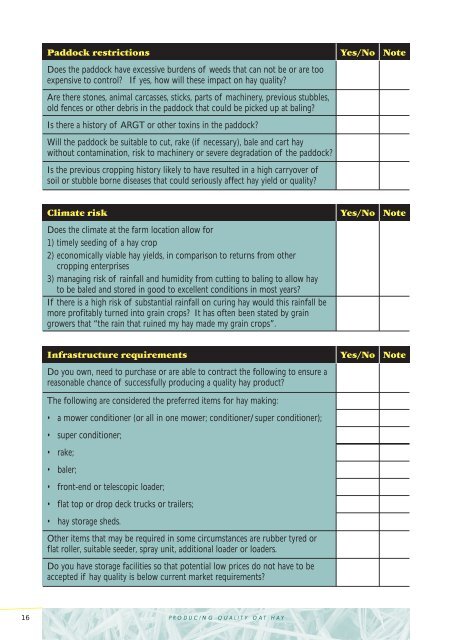You also want an ePaper? Increase the reach of your titles
YUMPU automatically turns print PDFs into web optimized ePapers that Google loves.
Paddock restrictions Yes/No Note<br />
Does the paddock have excessive burdens of weeds that can not be or are too<br />
expensive to control? If yes, how will these impact on hay quality?<br />
Are there stones, animal carcasses, sticks, parts of machinery, previous stubbles,<br />
old fences or other debris in the paddock that could be picked up at baling?<br />
Is there a history of ARGT or other toxins in the paddock?<br />
Will the paddock be suitable to cut, rake (if necessary), bale and cart hay<br />
without contamination, risk to machinery or severe degradation of the paddock?<br />
Is the previous cropping history likely to have resulted in a high carryover of<br />
soil or stubble borne diseases that could seriously affect hay yield or quality?<br />
Climate risk Yes/No Note<br />
Does the climate at the farm location allow for<br />
1) timely seeding of a hay crop<br />
2) economically viable hay yields, in comparison to returns from other<br />
cropping enterprises<br />
3) managing risk of rainfall and humidity from cutting to baling to allow hay<br />
to be baled and stored in good to excellent conditions in most years?<br />
If there is a high risk of substantial rainfall on curing hay would this rainfall be<br />
more profitably turned into grain crops? It has often been stated by grain<br />
growers that “the rain that ruined my hay made my grain crops”.<br />
Infrastructure requirements Yes/No Note<br />
Do you own, need to purchase or are able to contract the following to ensure a<br />
reasonable chance of successfully producing a quality hay product?<br />
The following are considered the preferred items for hay making:<br />
• a mower conditioner (or all in one mower; conditioner/super conditioner);<br />
• super conditioner;<br />
• rake;<br />
• baler;<br />
• front-end or telescopic loader;<br />
• flat top or drop deck trucks or trailers;<br />
• hay storage sheds.<br />
Other items that may be required in some circumstances are rubber tyred or<br />
flat roller, suitable seeder, spray unit, additional loader or loaders.<br />
Do you have storage facilities so that potential low prices do not have to be<br />
accepted if hay quality is below current market requirements?<br />
16 PRODUCING QUALITY OAT HAY

















